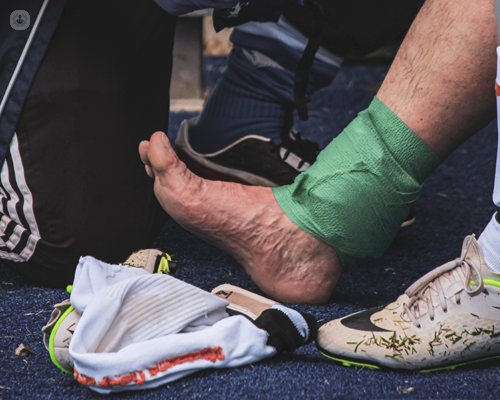All about ankle injuries in sports
Written in association with:Ankle sports injuries are common place but treatment is no less essential. We speak to leading orthopaedic foot and ankle surgeon Mr Barry Rose all about them, how they can be prevented and treatment in this informative article.

What are common ankle injuries in sports?
It is extremely common to sustain a sports injury to the foot or ankle. The most common ankle injury would usually be sustained by ‘twisting’ or ‘rolling’ the ankle, leading to an inversion injury. This usually results in a soft tissue injury to the ligaments, which is a sprain. The same mechanism however, could also cause other injuries including breaks to the bones around the foot and ankle.
Other very common ankle injuries include ruptures of the Achilles tendon. This is where the Achilles tendon snaps into two parts. People often describe this as feeling like they have been shot or hit in the back of the ankle. People may also injure the muscle itself slightly higher up the calf.
How can you prevent ankle injuries in sports?
The best way to prevent sports injuries is to ensure that you wear appropriate and well-fitting shoe wear, and to ensure that your soft tissues (muscles, tendons, ligaments), are as strong as possible to help support the foot and ankle.
Many people, especially those who have had an injury before, will use an ankle support to prevent recurrent sprains. You will see many high-level athletes wearing these. As always, warming up and warming down are an important part of all sporting activities.
How is a sprained ankle treated?
The initial treatment for a sprained ankle should be the same as for many other injuries. This will include ’RICE’: ‘Rest’, ‘Ice’, ‘Compression’ and ‘Elevation’. Bad injuries may require an ankle support, possibly a large boot. People with these injuries are able to weight-bear as tolerated, but often the ankle may be very painful and swollen in the early stages.
People should take painkillers as required and reduce activity until the pain settles. Most ankle sprains will improve over a few weeks, but the more serious ones can take up to six weeks to settle down. A small number of people will still have pain after this time. This may often be due to an injury not initially identified and further treatment may be required.
Many people will benefit from physiotherapy rehabilitation exercises as they recover to strengthen the ankle. Those with persistent pain often benefit from surgery to explore the ankle, and sometimes to reconstruct the ligaments.
What are some common foot injuries in sports?
Injuries to the foot are less common than those to the ankle. However, rolling the ankle can sometimes result in a broken bone within the foot. This is most commonly the fifth metatarsal.
This bone can also break following a direct blow on the foot. Most of these heal with a small number requiring surgical fixation. Other injuries in the foot include stress fractures, that sometimes are the result of over training, and, of course, broken toes which are very common, but rarely require treatment other than strapping.
Rarer injuries include ‘turf toe’ (hyper extension of the great toe resulting in injury to the joint capsule), or tendon ruptures following a laceration (for example, after dropping a sharp object on the foot).
How can you prevent foot injuries in sports?
Again, the best way to prevent injuries around the foot will involve the use of good, supportive and appropriate shoe wear for the sport being undertaken.
If you require assistance regarding an ankle sports injury or other orthopaedic foot conditions, arrange an appointment with Mr Rose via his Top Doctors profile.


